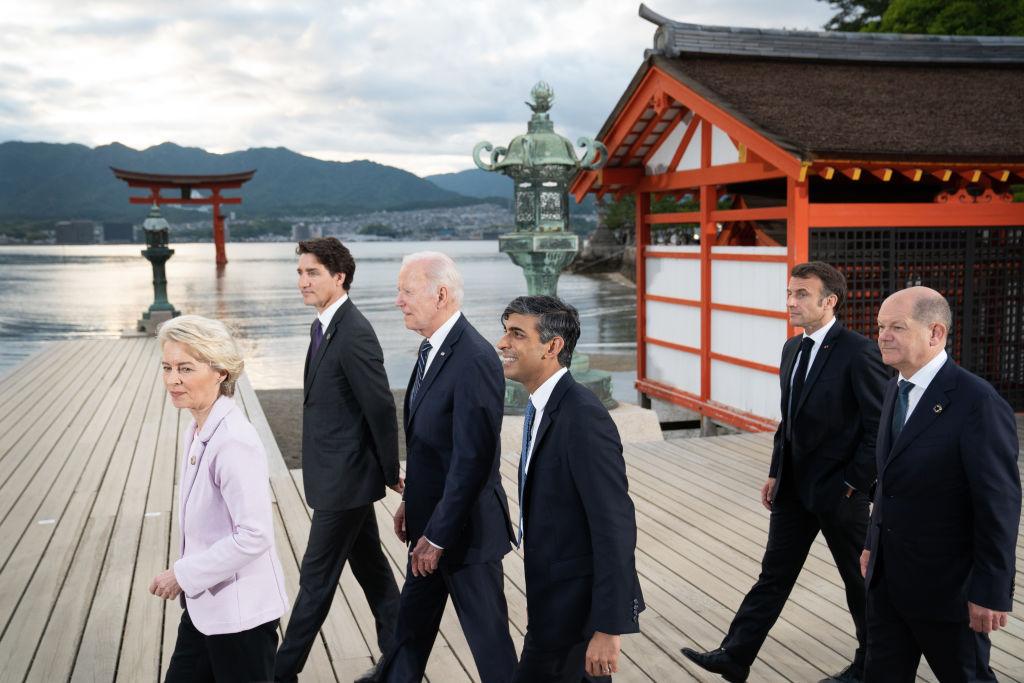The G7’s anti-coercion campaign against China could backfire
Posted By Lili Yan Ing on October 20, 2023 @ 15:00

On 28–29 October, Japan will host the G7 Trade Ministers’ Meeting in Osaka. The primary focus of the gathering will be improving supply-chain resilience [1] and strengthening export controls [2] on critical minerals and technologies. But China’s ‘economic coercion [3]’, particularly the widespread disruption caused by its non-transparent and market-distorting industrial policies [4], is also expected to be high on the agenda.
Since joining the World Trade Organization in 2001, China has repeatedly been accused of providing unfair industrial subsidies, resulting in multiple WTO dispute cases. In 2006, for example, the European Union [5], the United States [6] and Canada [7] complained that China was offering export subsidies to its automobile and auto parts industries, primarily through its ‘export base [8]’ programs. The WTO strictly prohibits export subsidies due to their significant trade-distorting effects.
In 2010, the US asserted [9] that China was subsidising its wind-power equipment manufacturers by offering grants to companies that used Chinese-made components. In 2017, the focus shifted [10] to alleged Chinese subsidies to large aluminium producers. And a year later, the WTO vindicated the federal government’s complaint that China was imposing countervailing and anti-dumping duties on broiler products [11] from the US.
Meanwhile, bilateral trade between China and South Korea has declined significantly amid rising geopolitical tensions and following China’s decision to exclude from its subsidies program electric-vehicle manufacturers that used South Korean battery packs. Trade relations between China and Australia also soured after China responded to then–Prime Minister Scott Morrison’s call [12] for an independent international investigation into the origins of the Covid-19 pandemic by imposing tariffs on Australian goods such as barley, wine [13], red meat, timber and lobsters [14].
Earlier this year, G7 leaders pledged [15] to combat all forms of economic coercion. But this effort could have far-reaching consequences, given that China accounts [16] for 19.4%, 7.5%, 6.8% and 6.5% of exports from Japan, the US, Germany and the UK, respectively. Should the group implement anti-coercion measures targeting China, Chinese President Xi Jinping might retaliate.
But, beyond the potential implications for G7 economies, the group’s anti-coercion campaign could negatively affect global trade. For starters, the vagueness of the term ‘economic coercion’ provides an opportunity not just for the G7 but for governments worldwide to use it as a pretext for protectionist measures, which could increase production costs and overall prices.
The EU defines [17] economic coercion as an attempt by a non-member state to pressure one or more of its members to take a specific action by implementing or threatening to implement measures that affect trade or investment relations between those countries. But while some tactics and tools are clearly coercive, there’s no clear explanation of what constitutes an action ‘against’ another country. Given this ambiguity, the term could apply to policies adopted by many countries.
Moreover, while the G7 has repeatedly emphasised [18] its view that export controls are a ‘fundamental policy tool’ to prevent critical technologies from being used for military purposes, such measures can distort [19] long-term resource allocation and global trade, undermine competitiveness and impede economic growth in both exporting and importing countries.
In a 1981 study, for example, Princeton economist Gene M. Grossman showed [20] that local content requirements often result in reduced output and higher prices for final goods, though their effects on domestic intermediate goods remain unclear and largely depend on market-specific factors and production processes. In a 1992 paper [21], Grossman and Elhanan Helpman outlined a trade-protection framework in which industries with higher import demand or export-supply elasticities deviate less from free-trade practices. And in 2012, Will Martin and Kym Anderson found [22] that shifts in trade policies, especially export restrictions, played a major role in driving up global staple-crop prices during the commodity booms of 1973–74 and 2006–08.
By adopting anti-coercion measures, G7 members may inadvertently encourage other countries to erect their own trade barriers. In 2022 alone, governments worldwide introduced nearly 3,000 protectionist measures [23] affecting investment and trade in goods and services. These actions, whether undertaken by individual countries or larger groupings, could exacerbate uncertainty and inhibit global trade.
This increasing fragmentation is already having a negative effect. While the value of global trade [24] reached US$49.5 trillion in 2022, the WTO recently lowered [25] its trade growth forecast for 2023 from 1.7% to 0.8%, citing trade disruptions and a manufacturing slowdown.
The G7 must take the lead in de-escalating tensions. By ensuring that the WTO operates effectively, and by avoiding punitive measures that pose a threat to economic stability, the group could steer global trade in the right direction.
Article printed from The Strategist: https://aspistrategist.ru
URL to article: /the-g7s-anti-coercion-campaign-against-china-could-backfire/
URLs in this post:
[1] supply-chain resilience: https://www.g7hiroshima.go.jp/ministerialmeetings/pdf/osaka_en.pdf
[2] export controls: https://www.reuters.com/world/asia-pacific/g7-trade-ministers-hold-first-meeting-year-amid-global-trade-tension-2023-04-04/
[3] economic coercion: https://www.bbc.com/news/world-asia-65662720
[4] industrial policies: https://www.macaubusiness.com/g7-trade-ministers-back-tech-export-controls/
[5] European Union: https://www.wto.org/english/tratop_e/dispu_e/cases_e/ds339_e.htm
[6] United States: https://www.wto.org/english/tratop_e/dispu_e/cases_e/ds340_e.htm
[7] Canada: https://www.wto.org/english/tratop_e/dispu_e/cases_e/ds342_e.htm
[8] export base: https://ustr.gov/about-us/policy-offices/press-office/fact-sheets/2012/september/wto-case-challenging-chinese-subsidies
[9] asserted: https://www.wto.org/english/tratop_e/dispu_e/cases_e/ds419_e.htm
[10] shifted: https://www.wto.org/english/tratop_e/dispu_e/cases_e/ds519_e.htm
[11] broiler products: https://www.wto.org/english/tratop_e/dispu_e/cases_e/ds427_e.htm
[12] call: https://www.reuters.com/article/us-health-coronavirus-australia-china/australia-says-world-needs-to-know-origins-of-covid-19-idUSKCN26H00T
[13] barley, wine: https://www.aph.gov.au/About_Parliament/Parliamentary_Departments/Parliamentary_Library/pubs/BriefingBook47p/AustraliaChinaRelations
[14] red meat, timber and lobsters: https://www.cnbc.com/2023/08/28/australia-wants-normalized-china-trade-ties-wants-trade-curbs-dropped.html
[15] pledged: https://www.reuters.com/world/g7-leaders-agree-new-initiative-fight-economic-coercion-2023-05-20/#:~:text=TOKYO%2C%20May%2020%20(Reuters),would%20fail%20and%20face%20consequences.
[16] accounts: https://stats.oecd.org/
[17] defines: https://ec.europa.eu/commission/presscorner/detail/en/IP_23_3046
[18] emphasised: https://www.mofa.go.jp/files/100487108.pdf
[19] distort: https://www.oecd.org/publications/the-economic-impact-of-export-restrictions-on-raw-materials-9789264096448-en.htm
[20] showed: https://academic.oup.com/qje/article-abstract/96/4/583/1883394?redirectedFrom=fulltext
[21] 1992 paper: https://www.nber.org/papers/w4149
[22] found: https://www.jstor.org/stable/41331269
[23] 3,000 protectionist measures: https://www.imf.org/en/Publications/fandd/issues/2023/06/the-costs-of-geoeconomic-fragmentation-bolhuis-chen-kett
[24] global trade: https://www.trademap.org/Bilateral_TS.aspx?nvpm=1%7c%7c41%7c000%7c%7cTOTAL%7c%7c%7c2%7c1%7c1%7c2%7c2%7c1%7c1%7c1%7c1%7c1
[25] lowered: https://www.wto.org/english/res_e/booksp_e/gtos_updt_oct23_e.pdf
Click here to print.